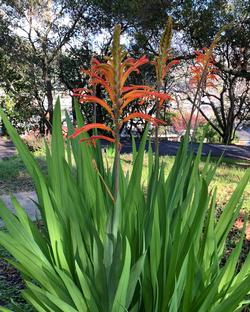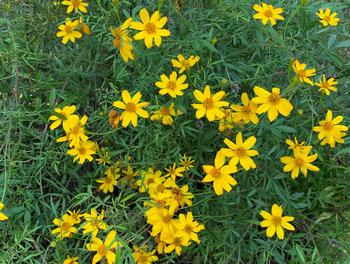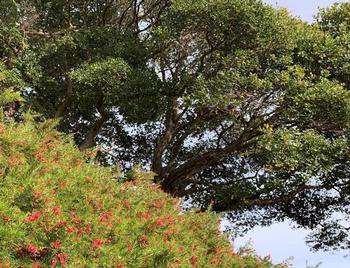Re-imagining our Marin gardens in a hotter, drier climate
-
Anne-Marie Walker
-
While December rains in Marin increased water reserves, nagging questions remain about what it means to garden in a hotter, drier climate. As a master gardener, I knew some plants grow better with soil moisture available throughout the year. Some plants adapted to summer-dry climates grow better with less to even no soil moisture in summer, and not all drought-tolerant plants are successful in summer-dry climates. I decided it was time to dig a little deeper to understand how plants adapt to climate and how we might begin to re-imagine gardens in a hotter, drier Marin climate. In my garden, I saw two plants thriving without supplemental water: Acanthus mollis and Chasmanthe floribunda. Carvings of Acanthus with its deeply lobed leaves and bold flower stems grace the tops of Corinthian columns. This Mediterranean native survives with little to no water, and its showy flower spikes are a source of nectar for bumblebees from spring through summer. Chasmanthe, native to South Africa, is in the iris family and blooms in winter, providing nectar to hummingbirds. Both Acanthus and Chasmanthe die back after bloom and have adapted to dry climates by storing water and food reserves underground. Plant growth begins again when rains return.
 Chasmanthe floribunda stores water and nutrients underground for our summer-dry climate. Photo: David S. WalkerPerhaps a less familiar summer-dry climate adaptation is to develop a double root system. Plants utilizing this strategy spend their first year developing a tap root that reaches deeply to survive its first summer. In the second year, the plant grows long surface roots that extend far from the stem. Such adapted plants include lupines and milkweeds, which require little to no water supplementation beyond the first year. A third survival strategy involves leaf adaptation, including texture, color, and size. For example, our native coast live oak has tough, leathery leaves with pores (stomata) on the soft, velvety underside. These pores close and become dormant during the dry summer. Other plants like rosemary have smaller leaves which minimize water loss; grevilleas and tagetes are more examples of plants with adaptive small leaves. This climate adaptation corresponds with decreased photosynthesis, which means slow plant growth and less garden waste. Yet other plants align their leaves vertically to reduce sun exposure. Can you think of any such plant? (hint: native grasses).
Chasmanthe floribunda stores water and nutrients underground for our summer-dry climate. Photo: David S. WalkerPerhaps a less familiar summer-dry climate adaptation is to develop a double root system. Plants utilizing this strategy spend their first year developing a tap root that reaches deeply to survive its first summer. In the second year, the plant grows long surface roots that extend far from the stem. Such adapted plants include lupines and milkweeds, which require little to no water supplementation beyond the first year. A third survival strategy involves leaf adaptation, including texture, color, and size. For example, our native coast live oak has tough, leathery leaves with pores (stomata) on the soft, velvety underside. These pores close and become dormant during the dry summer. Other plants like rosemary have smaller leaves which minimize water loss; grevilleas and tagetes are more examples of plants with adaptive small leaves. This climate adaptation corresponds with decreased photosynthesis, which means slow plant growth and less garden waste. Yet other plants align their leaves vertically to reduce sun exposure. Can you think of any such plant? (hint: native grasses). Small, fragrant leaves and fibrous roots of Tagetes lemmonii make it well adapted to drier climates. Photo: David S. WalkerNot to be overlooked are those plants with gray foliage which reflects sunlight reducing heat on the leaf surface. Some plants even grow long hairs to capture nighttime humidity. Gardeners appreciate plants like lavenders and yarrows for the color contrast afforded by their silvery gray-green leaves. It is worthy to note, plants that tolerate heat, drought, cold, and wind often remain compact in their native habitat. Many of these plants produce volatile plant oils that further protect the plant from heat and minimize water loss. It’s best to pinch these back in our gardens and not water them in summer. Summer watering can result in non-beneficial growth, increase the potential for disease and pest problems and reduce bloom production.
Small, fragrant leaves and fibrous roots of Tagetes lemmonii make it well adapted to drier climates. Photo: David S. WalkerNot to be overlooked are those plants with gray foliage which reflects sunlight reducing heat on the leaf surface. Some plants even grow long hairs to capture nighttime humidity. Gardeners appreciate plants like lavenders and yarrows for the color contrast afforded by their silvery gray-green leaves. It is worthy to note, plants that tolerate heat, drought, cold, and wind often remain compact in their native habitat. Many of these plants produce volatile plant oils that further protect the plant from heat and minimize water loss. It’s best to pinch these back in our gardens and not water them in summer. Summer watering can result in non-beneficial growth, increase the potential for disease and pest problems and reduce bloom production. The small leaf Grevillea blooms beneath the Coast Live Oak with tough leaves and a big taproot. Photo: David S. Walker
The small leaf Grevillea blooms beneath the Coast Live Oak with tough leaves and a big taproot. Photo: David S. WalkerFamiliarity with the remarkable survival strategies plants have developed to cope with drier conditions helps us learn to adopt summer-dry garden aesthetics. The challenge is to foster home landscapes that meet current requirements for water conservation, support for pollinators, and maintaining defensible space. A garden is never finished, and learning about the incredible richness and diversity of plant species and their adaptations to climate helps us re-imagine gardens that thrive in climates increasingly hotter and drier. You can see many of these plants at UC Marin Master Gardener Demonstration Gardens, Harvey’s Garden along the Old Rail Trail in Tiburon, and Falkirk Cultural Center in San Rafael. For more advice on selecting summer-dry plants, go to the Marin Master Gardener’s website at marinmg.ucanr.edu.



